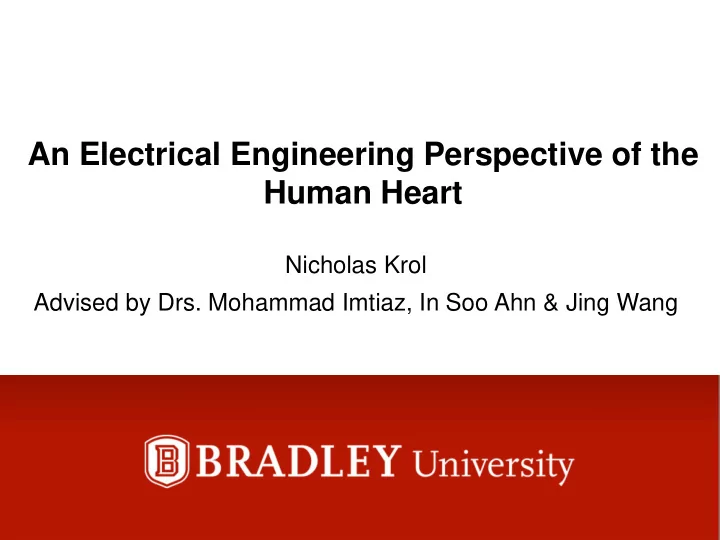

An Electrical Engineering Perspective of the Human Heart Nicholas Krol Advised by Drs. Mohammad Imtiaz, In Soo Ahn & Jing Wang
INTRODUCTION • Purpose: Aid medical professionals to better facilitate and understand heart function and dysfunction from an electrical engineering point of view • Question: How is electrical engineering related to the heart and how does electrical engineering help with the medical industry and understanding of biology?
The heart is an electrical organ and contracts in a specific and organized manner in order for blood to flow through the body The contractions are driven by propagating waves of depolarization, or current flow Heart .gif: https://en.wikipedia.org/wiki/Heart
http://www.pathophys.org/physiology-of-cardiac-conduction-and-contractility/
• Cardiac Arrest is caused by an arrhythmia, or abnormality in the heart rhythm which is an issue associated with the electrical system of the heart • The most common cause of cardiac arrest is an arrhythmia called ventricular fibrillation – when rapid, erratic electrical impulses causes the ventricles to quiver uselessly instead of pumping blood¹ (1) http://www.mayoclinic.org/diseases-conditions/sudden-cardiac-arrest/symptoms-causes/dxc-20164872
• Problems: 1. How electrical arrhythmia originates and sustains is not fully understood 2. The impact of structural defects and drug interactions on the heart is not fully understood • Solution: Develop Matlab programs to simulate the electrical system of the human heart in order to investigate and understand heart defects and drug interactions
TO ACHIEVE SOLUTION 1. Use Hodgkin-Huxley research to develop mathematical model which represents an excitable cardiac cell as an electrical circuit. 2. Produce Matlab programs to simulate the electrical system of the human heart 3. Perform high performance computerized simulations to predict disease and treatment strategies 4. Determine drug and heart interaction using in silico analysis
HODGKIN-HUXLEY EQUATIONS https://en.wikipedia.org/wiki/Hodgkin%E2%80%93Huxley_model
ELECTRICAL SYSTEM STAGES Simulate single cell Cell cable theory • 2D System • 3D System
RESULTS
RESULTS
RESULTS
RESULTS
CONCLUSIONS & FUTURE WORK • Aim to better understand the electrical activity of the heart • Use the modeling to observe drug and structural heart defect interactions to develop strategy for treatment • Develop 2D and 3D-cell system for investigation • Use patient specific data to simulate electrical system of patient’s heart
Questions? Nicholas Krol Advised by Drs. Mohammad Imtiaz, In Soo Ahn & Jing Wang
Recommend
More recommend